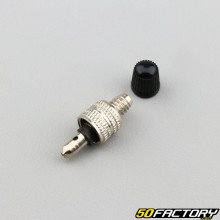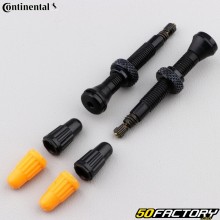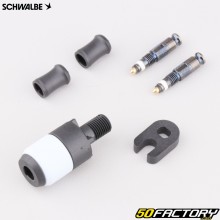 Valve
Valve
- IN STOCK0€70
-
- IN STOCK2€30
- IN STOCK2€70
-
-
-
- STOCK EXHAUSTED17€20
- IN STOCK18€60
- IN STOCK9€90
- IN STOCK1€10
- IN STOCK27€70
-
-
-
- IN STOCK20€00
Understanding the role of a valve on a balance bike
Definition
A valve is a small device installed on the inner tube of the tires. It allows to influence and maintain the air pressure inside the tire. The valves are designed to be airtight, thus preventing air leaks, and are essential to ensure that the tires remain properly inflated, which is crucial for the safety and comfort of the ride.
Role and importance in use
The valve plays a vital role in maintaining tire pressure. Properly inflated tires ensure better stability and maneuverability of the balance bike, which is especially important for young children who are still learning to ride. In addition, properly inflated tires reduce the risk of flat tires and extend the life of the tires.
The different types of valves
The Dunlop
The Dunlop valve, also called the English valve, is commonly used on bicycles in Europe. It is easy to inflate and compatible with most pumps. This valve is particularly appreciated for its simplicity and robustness. It is often used on balance bikes because of its ease of use and compatibility with standard inflation equipment.
The Schrader
The Schrader valve, also called the American valve, is the same valve found on car tires. It is wider and more robust than the Dunlop valve, which makes it particularly durable. Schrader valves are easy to use and compatible with car air pumps, which can be convenient for parents. However, they require a larger valve hole on the rim, which can limit their compatibility with some balance bikes.
La Presta
The Presta valve, or French valve, is thinner and lighter than the Dunlop and Schrader valves. It is commonly used on road bikes and high-performance bikes because of its ability to handle higher pressures. The Presta has a locking mechanism that helps maintain a stable pressure. Although less common on balance bikes, it can be used on some high-end models.
How to choose the right valve
The type of vehicle
The choice of valve depends mainly on the type of balance bike and the intended use. For a standard balance bike, a Dunlop or Schrader valve is often sufficient. However, for more powerful balance bikes or those used in specific conditions, a Presta valve may be considered.
Ease of use
Ease of use is a key factor. Schrader and Dunlop valves are easy to inflate and compatible with most pumps, making them convenient for parents. Presta valves, while more efficient, may require a little more care and familiarity to inflate.
Ease of inflation
Ease of inflation is crucial, especially for parents who need to keep their balance bike tires in good condition. Schrader and Dunlop valves are compatible with most air pumps available on the market, making the inflation process easier and faster. Presta valves, although requiring specific adapters, offer greater inflation precision.
Replacement
Preparing for replacement
Before replacing a valve, make sure you have the necessary tools: a new compatible valve, an adjustable wrench, a tire lever, and an air pump. Work in a clean, well-lit area to avoid losing small parts.
Replacement method
To replace a valve on a balance bike, follow these steps:
- Completely deflate the tire.
- Remove the tire from the rim using a tire lever.
- Gently remove the old valve from the inner tube.
- Insert the new valve into the hole in the rim.
- Reassemble the tire on the rim.
- Inflate the tire to the recommended pressure using a compatible pump.
- Check that the valve is secure and that there are no air leaks.
Care instructions
Tips for regular maintenance
Regular maintenance of valves is essential to ensure their proper functioning and extend their life. Here are some tips:
- Check tire pressure regularly and reinflate if necessary.
- Inspect the valves for leaks or signs of deterioration.
- Clean valves and caps to prevent dirt buildup.
- Replace worn or damaged valves immediately.
Signs that a replacement is needed
There are some signs that a valve needs to be replaced:
- Frequent air leaks.
- Valve visibly damaged or corroded.
- Difficulty inflating the tire or maintaining pressure.
- Hissing noise indicating an air leak.























